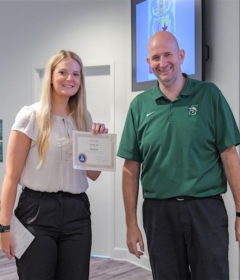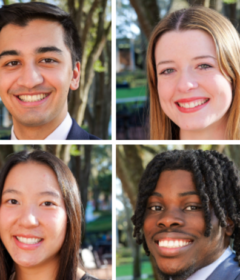The Libby Years
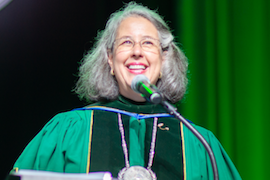
Editor’s note: This article appears in the Spring issue of Stetson University Magazine, now available online.
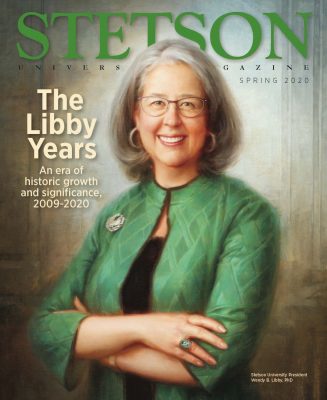
Wendy B. Libby, PhD
Wendy B. Libby, PhD, really wasn’t supposed to make it to Stetson.
Becoming a university president, in fact, “was never even on the radar screen,” she said in late 2019, just before entering what will be her final months in charge on campus.
“This was never a career choice,” she emphasized.
Yet, Libby sure made her presence felt.
On more than one occasion through the years, Libby used the word serendipity during her many speeches, as in “Stetson serendipity.” Turns out, she personified the term.
Libby arrived at Stetson in July 2009 as the ninth president and the first female president for a university that was founded in 1883. She was selected from 75 applicants following an 18-month search to oversee the DeLand campus, Stetson’s law school in Gulfport, and two satellite facilities in Tampa and Celebration.
With her announcement of retirement made in February 2019, Libby departs in June after 11 years in that top leadership role. She is being replaced by Christopher F. Roellke, PhD, who begins July 1, leaving Vassar College in Poughkeepsie, New York, where he served as Dean of the College from 2008 to 2018 and is a professor of education. In recognition of his contributions, Vassar named Roellke Dean of the College Emeritus.

Libby’s influence is palpable. And the results are undeniable, squarely placing her among the university’s most powerful, influential and dynamic leaders. Ever.
Not coincidentally, for more than the past year, there has been high praise.
At the February 2019 retirement announcement, Joe Cooper ’79, MBA ’82, chair of the Stetson University Board of Trustees, pointed to Libby’s “unparalleled vision and commitment” and “engaged leadership coupled with her financial savvy.”
Similarly, Nestor de Armas ’73, who was chair of the Board of Trustees when Libby was recruited as president, cited her “insight, her genuine care and concern for others, and her ability to expertly move forward the priorities of a complex organization.” For good measure, he described her impact as a “lasting legacy that will benefit Stetson for decades to come.”
Serendipity.
STETSON AT FIRST GLANCE
As Libby tells the story, when Stetson first called in 2008, she was quite content where she was in Columbia, Missouri, serving since 2003 as president at Stephens College, the second oldest women’s institute in America. Libby had spent the previous five years transforming Stephens both financially and academically.
Libby made the decision to interview largely out of respect for the person she suspected recommended her for the job. Also, Libby noted, after initial conversations, she was struck by Stetson’s past and potential.
“I had a sense of just my eye view of what was going on. But I was just stunned by what I found here in DeLand,” she said about her initial impression. “This was a place with really, really good bones — but that needed to be polished.”
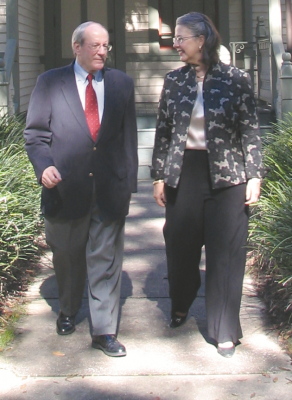
Popular Stetson President H. Douglas Lee, PhD, was retiring in May 2009. He had served as president since June 1987, and previously was executive vice president. Lee had advanced Stetson into a more diverse and socially responsible institution. Yet, new thinking had become needed, particularly with the nation’s economy in deep decline.
Libby’s conversations with Lee were warm and welcoming.
“This university had been cutting and cutting expenses, and I didn’t see this as an expense-control issue,” Libby explained. “I saw this as a revenue-growth issue. We couldn’t cut ourselves into heaven here; we had to grow our revenue in order to be able to invest in ourselves.”
Upon meeting people on campus during the interview process, Libby quickly emerged as the clear choice to take over.
THE ROAD TO DELAND
Libby’s credentials were hailed. Prior to the presidency at Stephens College, she served as vice president for business affairs and chief financial officer at Furman University from 1995 to 2003. Her administrative and teaching experience in higher education began in 1980 at institutions that included Westbrook College (now part of the University of New England), the University of Hartford, the University of Connecticut Health Center, The Ohio State University and Cornell University.
Her formal education: a doctorate in educational administration at the University of Connecticut; an MBA in finance at the Johnson Graduate School of Management, Cornell University; and a bachelor’s in biology/genetics from Cornell.
The blend of administrative expertise in higher education and finance acumen were uncommon.
Libby, nonetheless, never planned for a career in education, instead preferring the sciences mixed with the arts while growing up in Brooklyn, New York, in a rent-controlled building in a Jewish neighborhood, where “we never knew that we weren’t comfortable, never felt deprived.”
Her mother, raised Jewish, was born in Brooklyn, and her father, a Catholic, was born in the Bronx, with those boroughs adjoining opposite ends of Manhattan. They were married in the 1940s. A “super-smart” older brother, who ultimately received a graduate degree from MIT, helped pave the way for her academic success, Libby said, along with “super-competitive” classmates at local, public James Madison High School. Her peers were a group of students in advance-placement classes who were leaders, “even though I was probably one of the really nerdy ones,” Libby said with a smile. “Striving for excellence in academics was always key.”
In 2016, Libby was placed on the “Wall of Distinction” at James Madison High, alongside U.S. Sen. Bernie Sanders, Supreme Court Justice Ruth Bader Ginsburg and singer/songwriter Carole King, among others.
“New York was a great city to grow up in,” she added, “and I had a great family.”
Libby lived in Brooklyn until she left for college in 1968 with intentions of pursuing science. After doing two summer research projects, however, life in the lab didn’t suit her, and she had to find a way to earn a living. So, at Cornell, she entered hospital administration, in the business school, before realizing that subject area was too narrow. Then, finally, it was on to education.
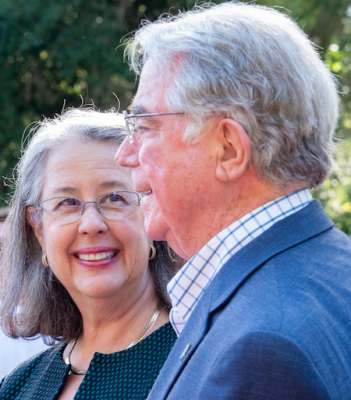
“If you go backwards and look at it, it probably doesn’t make sense,” Libby said. “Or, if you’re living through it, it probably doesn’t make sense. But it’s the reflection of a woman in the 1970s and ’80s who needed to be a chameleon, because we were still following our husbands’ careers.”
Libby’s moment of truth — or, in this case, person of truth — came in the form of Richard M. Libby, PhD, her second husband.
“My aha moment was marrying Richard,” she revealed.
The two had met during an Institute for Higher Education Business Management program at Stanford University. Richard Libby remembers the exact location, date and time, July 12, 1983, 10 a.m., in the lobby of Stanford Law School. They were married in September 1985.
At the time of meeting, she was in higher education, working at Cornell, but advancement was slow because people often stayed in their jobs until they retired. Richard Libby was president of Muskingum Area Technical College (now Zane State College) in Zanesville, Ohio, and thought a doctorate would make a difference in her career. Her words: “He kept saying that if you want to get anywhere in this profession, you need a doctorate. I resisted for a few years and then got the doctorate.”
Libby started that pursuit in 1988 and finished in 1994, commuting to the University of Connecticut at night for classes after work during the day.
“Richard saw something in me that I didn’t see. He saw a future in me that I didn’t see and had never considered,” Libby reflected.
“Then the world just changed for me. All of a sudden, I was unusual in that I had an MBA in finance and a PhD. … And, so, [Richard] was exactly right.”
Richard Libby, as it happened, was right for Stetson, too, bringing his own distinction, positive energy and caring.
Shortly after his arrival, he founded the Stetson Skeet and Trap Team (then under a different name), which now is an internationally competitive group with a growing endowment he also started.
Last September, “Richard’s Garage,” a stand-alone second garage at the President’s House, officially was dedicated with a naming in his honor. Prior to arriving at Stetson, the Libbys committed to donating the garage. Richard himself designed the structure while still in Missouri, mapping out every square foot, and together they funded its construction.
Mostly, Richard Libby emerged as both a cherished University Mentor and an ambassador for all things Stetson.
More serendipity.
GETTING STARTED ON CAMPUS
Almost instantly after taking office, Libby targeted faculty concerns. During her second interview for the job, background materials included a faculty survey, which indicated a strong desire for a provost, because the faculty had been without such a senior academic leader for a decade. Also, the faculty wanted a president who would strengthen Stetson’s financial stability and assure raises into the future.
Libby turned to Beth Paul, PhD, who remained at Stetson for seven years before leaving to become the president of Capital University in Columbus, Ohio. “I believe we delivered on all three of those [faculty concerns] fairly rapidly,” said Libby.
Subsequently, in January 2017, Libby named Noel Painter, PhD, as executive vice president and provost to replace Paul.
Those two moves have been hugely impactful and emblematic of her leadership style.
To be successful, Libby often has said, you must “hire people who are better than you, categorically.” And then you “support them and you get out of their way.”
Libby, likewise, acted quickly on multiple other fronts. She turned her attention to the physical appearance of the university, and in 2010, Stetson underwent a $6 million renovation of classrooms, classroom technology, building exteriors and landscaping.
One example: Nearly all of the campus began to receive reclaimed wastewater for irrigation from the City of DeLand. Also, following Lee’s lead, native trees took root, along with flowers, shrubs and ground covers, all typically requiring little or no irrigation.
Much of the work was (and continues to be) achieved under the American College & University Presidents’ Climate Commitment, an initiative to help eliminate net greenhouse gas emissions from specified campus operations and promote related education. That initiative had begun in 2007 under Lee.
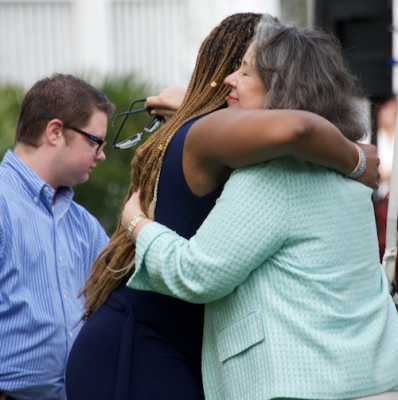
In the highly competitive student-enrollment marketplace, Libby believed, first impressions count in a big way. “Does this place look like a place I can imagine myself learning? Does it have pride in itself? What does it feel like? And you don’t have much time to make that impression,” she said in December.
Early returns on those initiatives came from national recognition. The Arbor Day Founda-tion named Stetson as a 2014 Tree Campus USA. A year later, Stetson was listed as a “Green College” in The Princeton Review’s Guide to 353 Green Colleges: 2015 Edition.
That was only the start. Most recently, 231 solar panels, partly funded by the students and installed atop the Carlton Union Building on campus, generate electricity and reflect on a continuing universitywide commitment.
PLANNING FOR CHANGE
In 2011, at the completion of a comprehensive strategic planning process to build a stronger, shared university identity, Libby and the university unveiled its Strategic Map: 2011-2014, representing the overarching goal of fostering innovation to move Stetson from “success to significance.”
Energies were focused on increasing national prominence, strengthening recruitment and retention, and raising academic quality, along with developing the university as a great place to work. Other areas of emphasis were enhancing the university’s financial stability and examining university values more deeply.
“As good as that map was in helping to guide the university in addressing obstacles and change, it was just a start,” Libby described.
Three years later, some of the same people who worked on the original map gathered again to tackle the work for a second time, ultimately producing a 2014-2019 Strategic Map to guide the university forward to address one central challenge: “establish Stetson as a university of choice for innovative approaches to tackling complex challenges.”
Focal points were expansive. They encompassed demonstrating distinctiveness and value; enhancing excellence and innovation in learning; empowering lifelong success and significance; increasing organizational resilience and adaptability; expanding and strengthening strategic partnerships; and being a diverse community of inclusive excellence.
“The Strategic Map is not a roadmap carved in stone,” Libby said at the time. “It is a dynamic plan that we will adjust as we go, shifting our focus to new priorities as we accomplish others and ensuring we stay on the critical path.”
And the planning hasn’t stopped. Now, with Roellke poised to take the reins, the Stetson University Board of Trustees approved focused Roll Ahead Strategic Map Goals — based on the 2014-2019 Strategic Map — to direct the university for the next two years.
Libby referred to the Roll Ahead map as a “transitional bridge,” affording Roellke time to get settled and assess. Libby’s own plan is to be supportive. “That’s really important,” she said.
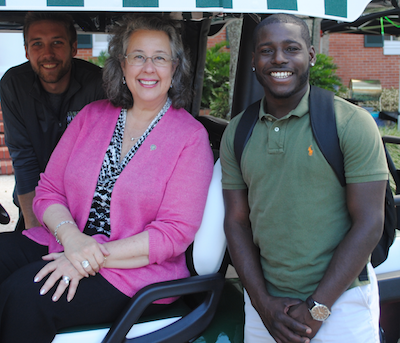
Generally, Libby’s tenure has been highlighted by growth in student enrollment, strengthened academic rigor, improved financial position, enhanced campus life with inclusion and equity as foundational commitments, the addition of new facilities, and an award-winning physical appearance.
That, as the saying goes, is a mouthful.
Further, that one central challenge — to “establish Stetson as a university of choice for innovative approaches to tackling complex challenges” — has been met, even exceeded.
“We have moved Stetson forward on all fronts,” Libby said during her retirement announcement in February 2019.
REFLECTING ON HER TENURE
Since last year, purely by observation, Libby has been especially careful in measuring her steps. With the leadership transition approaching, she is sensitive of time and place.
Libby’s speech to faculty and staff last August, just as her final academic year as president was beginning, is especially noteworthy. She had given literally hundreds of such speeches throughout her tenure. This one perhaps caused substantial anxiety. So, she wrote it out entirely, word for word, not using her usual bullet points, and with phrases selected for appropriate inflection.
Simply, Libby wanted to use that speech to remind people of the positive outlook for the university — forward-thinking, all-inclusive “One Stetson” — with the thought of delivering the best possible university to the next president.
Among her first words that morning were “we, together.” Talking in December about that speech, Libby expressed great relief.
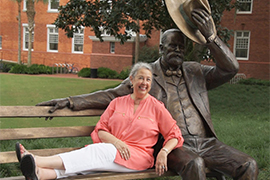
Looking back, Libby largely is content with the past 11 years, particularly in uniting the university. The galvanizing initiative of Many Voices, One Stetson has been a special cause to her. “I think we’ve moved really far in helping everyone believe that the multiple parts of this university together make one university,” she commented.
University namesake John B. Stetson even returned — in the form of a larger-than-life bronze statue that was dedicated to Libby. The donor-funded sculpture, weighing approximately 1,600 pounds including a bench, was installed in Palm Court just days before her final academic year began. The Stetson piece was commissioned with the support of former university Trustee Troy Templeton ’82, MBA ’83 and his wife, Sissy.
Still, Libby sees looming challenges. While pleased with the success of the university’s recent fundraising effort, the Beyond Success – Significance Campaign, she cannot keep from thinking ahead. “For the next campaign,” she said in December, “we need to know who’s ready to step up.”
Also, she sees the challenge of change at Stetson. “In the academic world, we are still in a fairly traditional place,” she said. “And we’ve managed to be successful still being fairly traditional, but we probably need to start looking at new ways to deliver our programs, and to new populations. I think we all have to stretch our expectations of what a Stetson degree should be like.”
And she concedes that criticism hasn’t always been easy on her. “I’m normal,” she said. “But I was hired to leave Stetson better than I found it. And that’s what I’m doing. And I have to be crystal clear in my belief that that is what I’m doing. Then you just set your sights forward and keep going.
“It would be lovely if we’re all having kumbaya moments with each other all the time. But you don’t learn if you don’t have friction and tension. And the only thing that ever bothers me is when people close their minds and don’t want to learn.”
Yet, through it all, quite apparently, Libby hasn’t lost her sense of humor. How has Stetson changed you, she was asked. Her response: “My wardrobe is much greener!”
LOOKING AHEAD
So now, both Libby and Stetson must move forward. And Libby is far from done. She is wanted.
As word spread about her upcoming availability, Libby received numerous inquiries about helping in one capacity or another. Early last fall, for example, she received an email about serving as vice-chair of the Division I Presidents Forum of the NCAA. Each of the 32 conferences in Division I sends one president to the forum, which deals with the intersection of academics and athletics. She’s in her second year as a representative of Stetson’s ASUN Conference. Now, she could be a leader. Again.
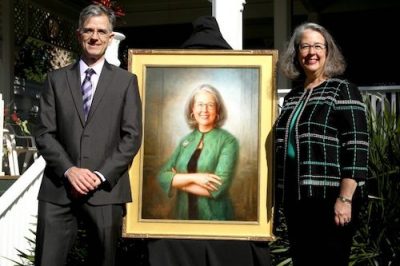
“People have asked ‘what are you going to do in your retirement?’ I’m not setting an alarm clock,” she said before rattling off to-do’s that ranged from “finishing reading the book for my monthly book club get-together” and “spending time with my husband” to “remembering how to cook” and “going to the theater more often.”
“I’ve heard that ‘people are going to be coming after you to do things.’ I have no expectation of that. And yet, I am getting some feelers.”
One certainty, Libby insisted, is that there will not be another full-time job.
The Libbys are moving out of their presidential home across from campus and have purchased a house in DeLand, which they’re renovating. He has expertise in residential architecture, and she is an “incredible interior decorator,” Richard Libby said in February, adding that “she is having the time of her life.”
Wendy B. Libby, PhD, is ready to step away, or at least step back. How does she want to be remembered? She didn’t hesitate. She beamed.
A presidential portrait of Libby had been painted, fittingly by an alumnus, Tom Reis ’88, and presented to her during Homecoming 2018. It now hangs with other presidents’ portraits in DeLand Hall.
“I want to be remembered the way my portrait looks,” Libby concluded. “Somebody who looks like she knows what she’s doing. But who looks warm and approachable.”
– Michael Candelaria

